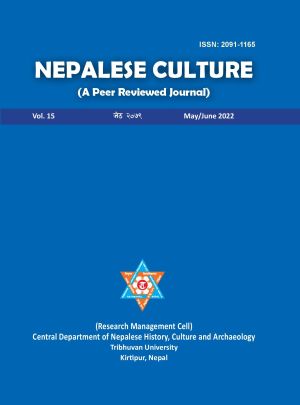The Temple having Multiple Names and Tantrik Images: Rani Pokhari
DOI:
https://doi.org/10.3126/nc.v15i1.48530Keywords:
Harishankari, Parameshwor Parameshswori, Swastika yantra, Vatuk Bhairav, KichkanyaAbstract
Rani pokhari lies at the heart of Kathmandu city. It was located at the north eastern boundary of Hanumandhoka royal palace during the medieval period. It was constructed by King Pratap Malla of Kathmandu in N.S. 789/790 (1668/69 C.E.). Its original name is Nhu: pukhu as the king constructed a new pond in the city, which later became famous by the name “Rani pokhari.” Among hundreds of monuments of the Kathmandu valley, Rani pokhari is one, which along with its pleasant beauty, reflects marvelous art and architecture of medieval history. It is a monument dedicated to a deceased son by a parent with the wish of absolution of his soul. The granthakut styled deval established at the center of Rani pokhari is popular by several names as Balgopaleshwor, Yamaleshwor, Harishankari and Gaurishankar. A number of stone and terracotta images placed inside and outside the temple of Rani pokhari, and its premises reveals the essence of utmost tantrism mingled art of the medieval period. Detailed study about the naming of a deval, specific motive of placement of various images and their features have not been conducted yet. In this context, what is the temple actually named after? Which images are established in or around the temple and at the pond premises? What does the specific design of a pond and its iconographic features reveal? are the questions raised in this research and the answer is intended to be addressed. To find out the actual name of a temple, the identification of its images and the purpose of their placement along with their features is an objective of this research. This is mainly an explorative and qualitative research based upon the historical documents and monuments located at the site. Survey of site, collection of inscriptions, myths, legends, photography of images, interview with the concerned authorities and a review of related literature are the methodologies applied for the research. Through various references, it has been known in this article that the actual name of the deval of Rani Pokhari is Parameshwor Parameswori. King Pratap Malla constructed the pond in swastika yantra or mandala design and established syaumya and raudra form of deities for the liberation and eternal peace of his deceased son Chakravertendra Malla, to protect his spirit from wandering, disclosing the fault of tantric symbols engraved in coins and for the protection and welfare of his clan.
Downloads
Downloads
Published
How to Cite
Issue
Section
License
© Central Department of Nepalese History, Culture and Archaeology, Tribhuvan University




